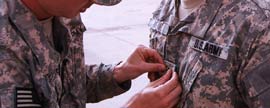The short answer is No! There is no official reference to share this subject, but occasionally organizations publish local policy at the Division, BDE, or BN level that clarifies the command’s position on issues of this nature.
Now for clarification. Let’s say the Soldier has difficulty wearing the uniform correctly and you decide to have them report every hour on the hour in a different uniform for inspection. In this case I would encourage the leader to show up in the same uniform as this removes the perception of punishment from the corrective training and sends a message to the Soldier:
“My leader cares and he will uphold the same standard he requires of me. Also, my leader is a little crazy. He is willing to give up his free time to correct my performance.”
The Soldier usually realizes that he would rather improve his performance than deal with a crazy NCO.
There are times when it might not be practical for you to be in the same uniform. Let’s say the Soldier failed to perform maintenance correctly on a vehicle. You decide to have the Soldier change the oil or perform some other aspect of maintenance in the evening and you are also scheduled for courtesy patrol which requires you to be in Class A or Class B uniform at 18:30 hours. In this case you may have the Soldier wear an old pair of ACUs or a pair of coveralls but time does not permit you to change uniforms or the requirements of the training would force you to shower prior to performing courtesy patrol. In short you would not have the time or the facilities to shower and report to duty as required. In a case like this it would be appropriate to reschedule the training or be in a different uniform. It is my opinion that the leader should be proactive and defuse the issue by addressing the Soldier prior to starting the training. You could explain, “Typically, out of professional courtesy–not requirement, I would be in the same uniform as you. Unfortunately duty requirements this evening did not afford me the ability to do so.”
Now keep in mind my goal is to educate the Soldier, diffuse his argument by addressing it before he can complain, and make it clear that there is no regulatory requirement for you to be in matching uniforms. If you choose to do so, you do it out of professionalism. Keep in mind corrective training cannot be punishment or perceived as punishment. Act in a professional manner to decrease the likelihood of your training being perceived as punishment.
From a personal perspective, I required my leaders to be in the same uniform as their Soldier when conducting corrective training… at least 99% of the time. There are always exceptions. Take this tidbit for what it is worth. It’s my opinion.
For additional information on corrective training see AR 27-10
Read The Mentor: Everything you need to know about leadership and counseling for more information about Counseling, Leadership, Corrective Training, and Separations in the Army.












